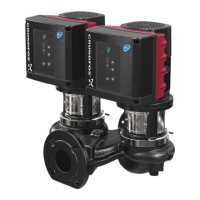37
English (US)
• Influence table with Stop at Max.
The setpoint is influenced by a curve made out of two to eight
points. There will be a straight line between the points and a
horizontal line before the first point and after the last point.
If the input signal is above 90 %, the pump will change to
operating mode "Min.".
If the input signal is reduced below 85 %, the operating mode
will be changed back to "Normal".
See fig. 62.
Fig. 62 Influence table with Stop at Max.
15.15.2 Predefined setpoints
Seven predefined setpoints can be set and activated by
combining the input signals to digital inputs 2, 3 and 4 as shown
in the table below.
15.15.3 Temperature influence
When you enable this function in proportional- or
constant-pressure control mode, the setpoint for head will be
reduced according to the liquid temperature.
Temperature influence can be set to function at liquid
temperatures below +176 °F or +122 °F (80 °C or 50 °C).
These temperature limits are called T
max.
. The setpoint is
reduced in relation to the head set (= 100 %) according to the
characteristics below.
Fig. 63 Select the measured parameter of Pt100/1000 input 2
In the above example, T
max.
= +176 °F (+80 °C) has been
selected.
The actual liquid temperature T
actual
causes the setpoint for head
to be reduced from 100 % to H
actual
.
The temperature influence function requires the following:
• Proportional-pressure, constant-pressure or constant-curve
control mode.
• Pump installed in flow pipe.
• System with flow-pipe temperature control.
Temperature influence is suitable for the following systems:
• Systems with variable flows (for example two-pipe heating
systems) in which the enabling of the temperature influence
function will ensure a further reduction of the pump
performance in periods with small heating demands and
consequently a reduced flow-pipe temperature.
• Systems with almost constant flows (for example one-pipe
heating systems and underfloor heating systems), in which
variable heating demands cannot be registered as changes in
the head as is the case with two-pipe heating systems. In such
systems, you can only adjust the pump performance by
enabling the temperature influence function.
Selection of T
max.
In systems with a dimensioned flow-pipe temperature of:
• up to and including +131 °F (+55 °C),
select T
max.
= +122 °F (+50 °C)
• above +131 °F (+55 °C), select T
max.
= +176 °F (80 °C).
TM05 6286 4612
Pump variant Predefined setpoints
TPE3 (D) ●
TPE2 (D) ●
Digital inputs
Setpoint
234
0 0 0 Normal setpoint
100Predefined setpoint 1
010Predefined setpoint 2
110Predefined setpoint 3
001Predefined setpoint 4
101Predefined setpoint 5
011Predefined setpoint 6
111Predefined setpoint 7
Setpoint influence [%]
External
input [%]
Normal
Min. or
Stop
Pump variant Temperature influence
TPE3 (D) ●
TPE2 (D) -
TM05 7946 1613
You cannot use the temperature influence
function in air-conditioning and cooling systems.
H
T [°F]
30 %
68 122 176
T [°C]
20 50 80
100 %
H
actual
T
actual
H
Q

